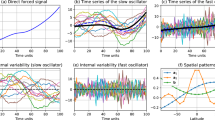Abstract.
The multi-variate optimal fingerprint method for the detection of an externally forced climate change signal in the presence of natural internal variability is extended to the attribution problem. To determine whether a climate change signal which has been detected in observed climate data can be attributed to a particular climate forcing mechanism, or combination of mechanisms, the predicted space–time dependent climate change signal patterns for the candidate climate forcings must be specified. In addition to the signal patterns, the method requires input information on the space–time dependent covariance matrices of the natural climate variability and of the errors of the predicted signal patterns. The detection and attribution problem is treated as a sequence of individual consistency tests applied to all candidate forcing mechanisms, as well as to the null hypothesis that no climate change has taken place, within the phase space spanned by the predicted climate change patterns. As output the method yields a significance level for the detection of a climate change signal in the observed data and individual confidence levels for the consistency of the retrieved climate change signal with each of the forcing mechanisms. A statistically significant climate change signal is regarded as consistent with a given forcing mechanism if the statistical confidence level exceeds a given critical value, but is attributed to that forcing only if all other candidate climate change mechanisms (from a finite set of proposed mechanisms) are rejected at that confidence level. Although all relations can be readily expressed in standard matrix notation, the analysis is carried out using tensor notation, with a metric given by the natural-variability covariance matrix. This simplifies the derivations and clarifies the invariant relation between the covariant signal patterns and their contravariant fingerprint counterparts. The signal patterns define the reduced vector space in which the climate trajectories are analyzed, while the fingerprints are needed to project the climate trajectories onto this reduced space.
Similar content being viewed by others
Author information
Authors and Affiliations
Additional information
Received: 19 April 1996/Accepted: 21 April 1997
Rights and permissions
About this article
Cite this article
Hasselmann, K. Multi-pattern fingerprint method for detection and attribution of climate change. Climate Dynamics 13, 601–611 (1997). https://doi.org/10.1007/s003820050185
Issue Date:
DOI: https://doi.org/10.1007/s003820050185




